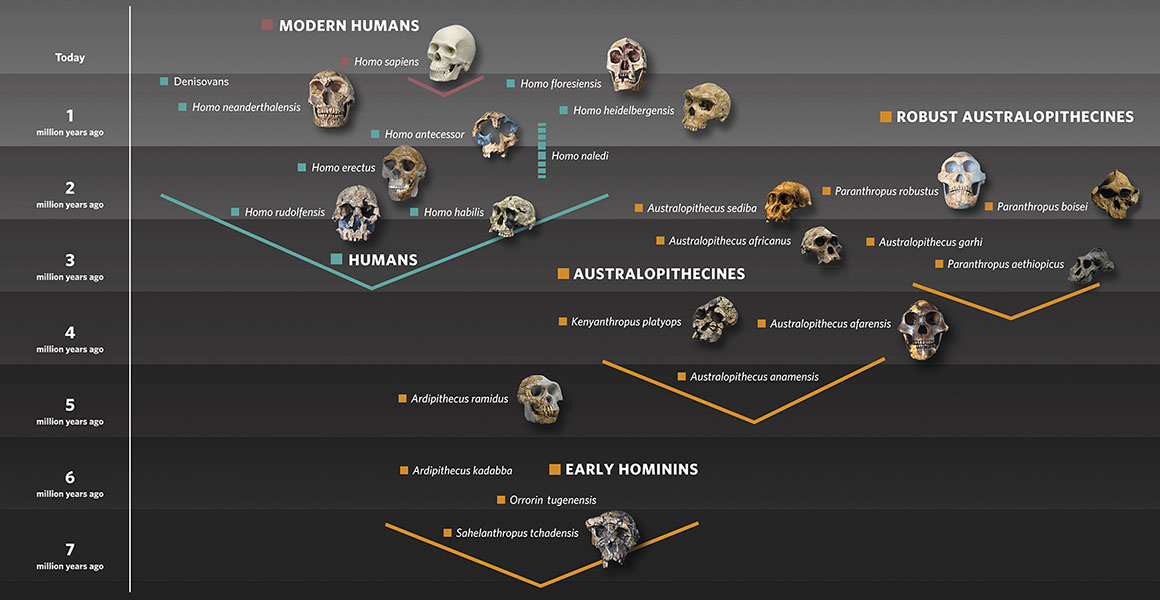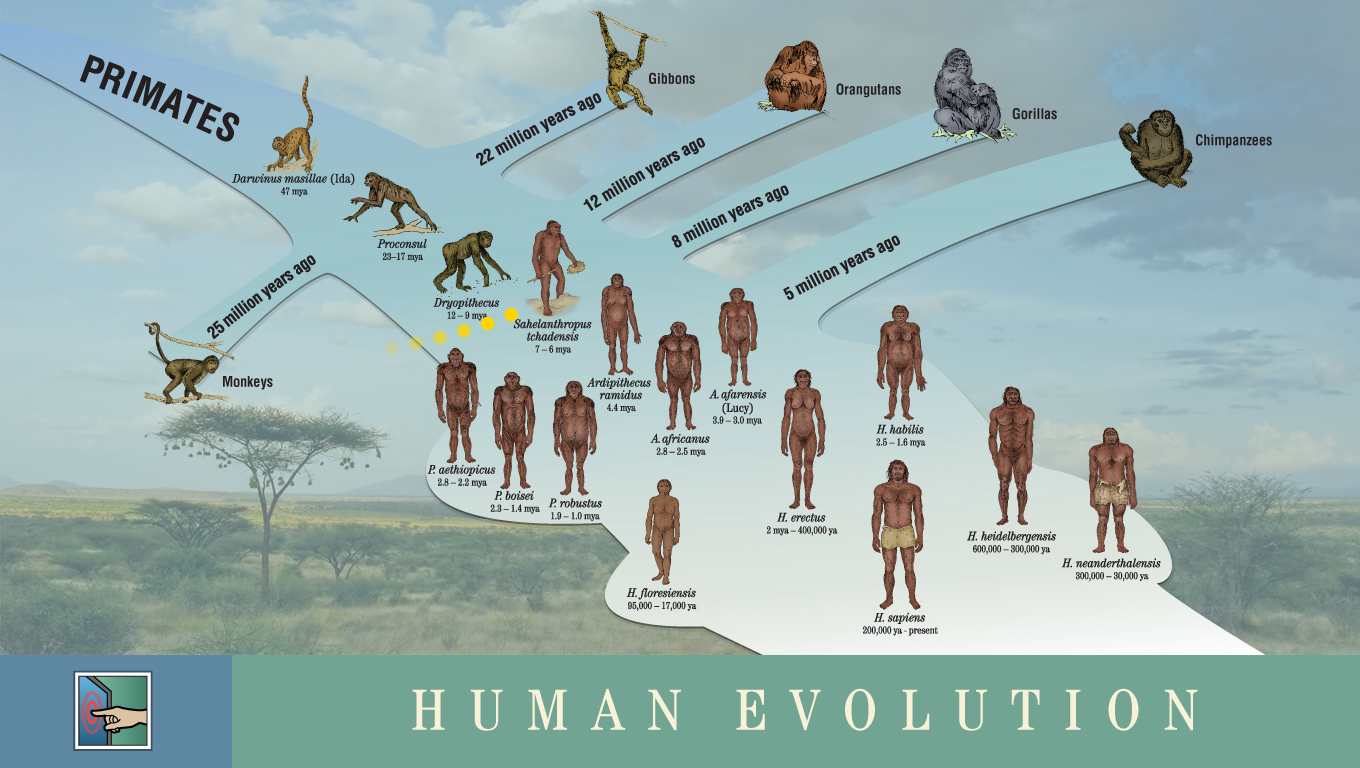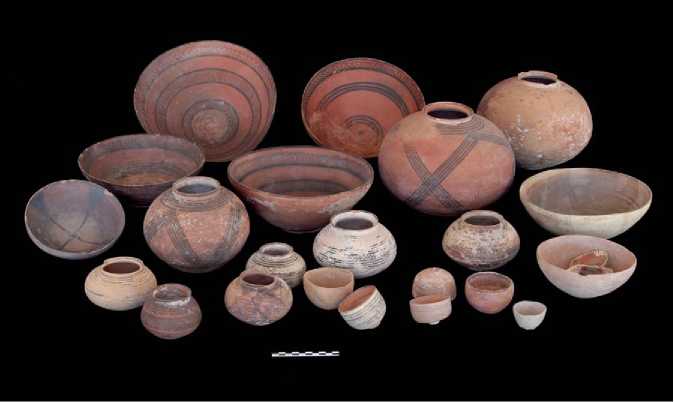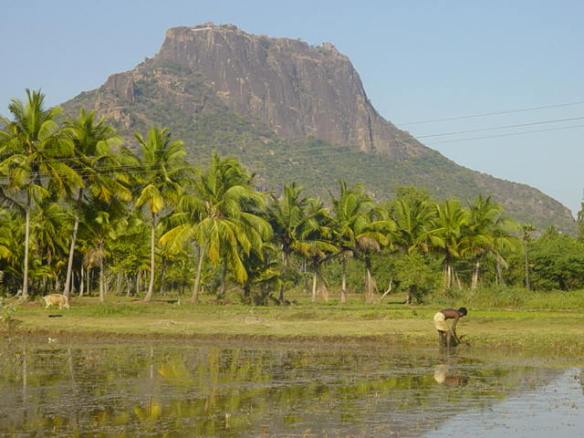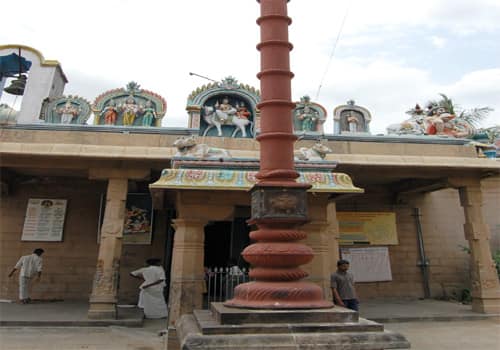
"In their antiquity and in their contemporaneity, there is not much else in any Indian literature equal to these quiet and dramatic Tamil poems. In their values and stances, they represent a mature classical poetry: passion is balanced by courtesy, transparency by ironies and nuances of design, impersonality by vivid detail, austerity of line by richness of implication. These poems are not just the earliest evidence of the Tamil genius." - A.K.Ramanujan on Sangam Literature.
Three small clay tablets, inscribed with complex 'cuneiform' script, comprise thirty-five Akkadian recipes with cooking instructions. The cuneiform tablets were inscribed during First Babylonian dynasty. These records stand as the most ancient cook-book in the world goes back as far as the second millennium B.C. These recipes were decoded and translated. Since it is difficult to decode the language of the Indus Valley Civilization, scholars find it difficult to name the dishes from this civilization. The main ingredients of their dishes were wheat and barley. With this nine more crops have been identified.
Sangam Tamil literature and Sangam Tamil civilization unveil the sophisticated ancient Tamil culture. Sangam literature is a record of the history of ancient Tamilakam of about 600 years (300 B.C. to 300 A.D.). The Sangam Tamil poets have left these breathtaking poems for all of us to relish. The poems have abundant references about rich Sangam Tamil cuisine. Pathuppattu poems detail about the generosity of kings and chieftains and provide explicit descriptions of both vegetarian and non-vegetarian food that they gave to the bards. Eight anthologies (Ettuthokai) poems provide pictorial details of the Sangam Tamil society. Purananuru and Patitrupattu poems detail the foods and drinks of ancient Tamil society. Akam poems or love poems (Akananuru, Narrinai, Kuruntokai, Ainkurunuru, and Kalittokai) also bring out graphic description of food and drinks. Sangam Tamil Cuisine has the unique style of preparing food. The cooking style is characterized by identifiable ingredients, cooking processes and proficiency. It is unique and associated with Sangam civilization.

Sangam Era culture have a recognizable cuisine, a specific set of cooking traditions. The six tastes of Tamils are 1. Sweet 2. pungent (mirchi) 3.bitter 4. Salt. 5. sour. and 6. astringent. Over the years Sangam Era gastronomy has greatly evolved and they have used characteristic spices and the combination of flavors unique to Sangam period. The Sangam Era culinary had unique flavors, the tangy twist and the plethora of vegetables were used in their recipes. The gastronomy of Sangam Tamil cuisine was dominated by rice, lentils, tamarind, coconut and curry leaves. Rice was the major staple food of most of the Sangam Tamil people. Cooked rice was known in different names in Sangam literature. Choodamani Nigandu (சூடாமணி நிகண்டு), Tamil thesaurus lists out related terms: Atisil (அடிசில்), Amalai (அமலை), Amizhthu (அமிழ்து), Annam (அன்னம்), Arru (அற்று), Asanam (அசனம்), Ayini (அயினி), Avi (அவி), Avizh (அவிழ்), Azhini (அழினி), Othanam (ஓதனம்), Un (ஊன்), Una (உணா), Undi (உண்டி), Kondri (கொன்றி), Kuzh (கூழ்), Madai (மடை), Mural (மூரல்), Misai (மிசை), Mithavai (மிதவை), Nimiral (நிமிரல்), Palitham (பாளிதம்), Parukkai (பருக்கை), Patham (பதம்), Pathu (பாத்து), Pomman (பொம்மன்), Ponagam (போனகம்), Puka (புகா), Punkam (புன்கம்), Puzhukkal (புழுக்கல்), Saru (சரு), Sondri (சொன்றி), Soru (சோறு), Thori (தோரி), Thurru (துற்று) and Valsi (வல்சி). They were by no means vegetarians. Therefore the food had a wide range of vegetarian and non-vegetarian delicacies.
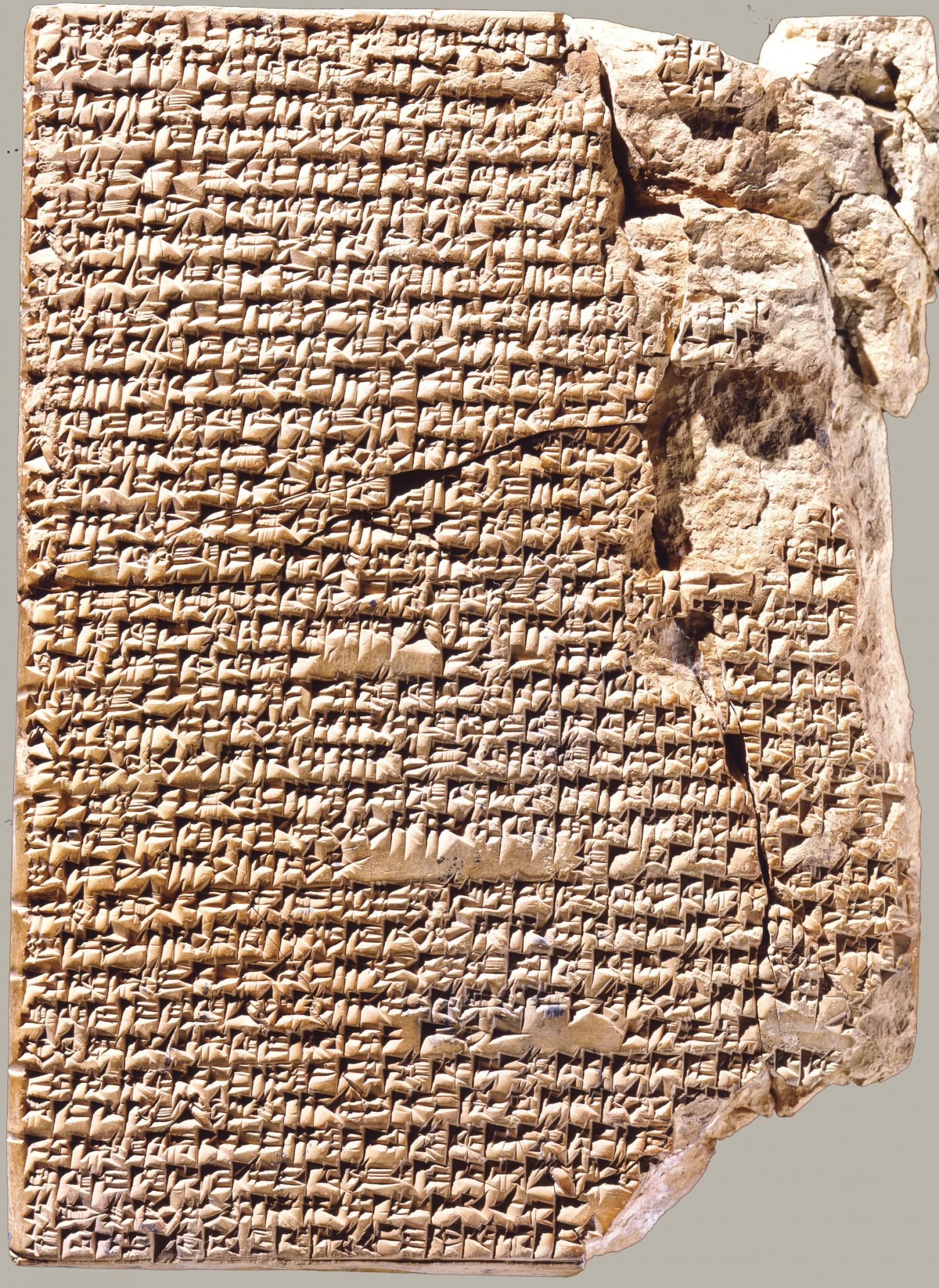 |
| Babylonian Stew Recipes in Cuneiform Tablets |

Sangam Era culture have a recognizable cuisine, a specific set of cooking traditions. The six tastes of Tamils are 1. Sweet 2. pungent (mirchi) 3.bitter 4. Salt. 5. sour. and 6. astringent. Over the years Sangam Era gastronomy has greatly evolved and they have used characteristic spices and the combination of flavors unique to Sangam period. The Sangam Era culinary had unique flavors, the tangy twist and the plethora of vegetables were used in their recipes. The gastronomy of Sangam Tamil cuisine was dominated by rice, lentils, tamarind, coconut and curry leaves. Rice was the major staple food of most of the Sangam Tamil people. Cooked rice was known in different names in Sangam literature. Choodamani Nigandu (சூடாமணி நிகண்டு), Tamil thesaurus lists out related terms: Atisil (அடிசில்), Amalai (அமலை), Amizhthu (அமிழ்து), Annam (அன்னம்), Arru (அற்று), Asanam (அசனம்), Ayini (அயினி), Avi (அவி), Avizh (அவிழ்), Azhini (அழினி), Othanam (ஓதனம்), Un (ஊன்), Una (உணா), Undi (உண்டி), Kondri (கொன்றி), Kuzh (கூழ்), Madai (மடை), Mural (மூரல்), Misai (மிசை), Mithavai (மிதவை), Nimiral (நிமிரல்), Palitham (பாளிதம்), Parukkai (பருக்கை), Patham (பதம்), Pathu (பாத்து), Pomman (பொம்மன்), Ponagam (போனகம்), Puka (புகா), Punkam (புன்கம்), Puzhukkal (புழுக்கல்), Saru (சரு), Sondri (சொன்றி), Soru (சோறு), Thori (தோரி), Thurru (துற்று) and Valsi (வல்சி). They were by no means vegetarians. Therefore the food had a wide range of vegetarian and non-vegetarian delicacies.
 |
| Saint. Tiruvalluvar, |
Tamil philosophy is "let food be thy medicine and medicine be thy food." Tirukkural, composed by Tiruvalluvar, the most celebrated Tamil poet-saint, is considered as unparallel, universal scripture. It comprises of 1330 aphorisms in couplets organized in 133 chapters under three heads -- Virtue, Wealth and Love. Tiruvalluvar’s couplets on Medicine ( 95th chapter) are highly aphoristic: "no medicine is necessary for him who eats after assuring (himself) that what he has (already) eaten has been digested."
மருந்தென வேண்டாவாம் யாக்கைக்கு அருந்தியது
அற்றது போற்றி உணின்
(Tirukkural (திருக்குறள்) 942: Poet Tiruvalluvar)
No need of medicine to heal your body's pain,
If, what you ate before digested well, you eat again.
Thamilakam
"The word Thamilakam was used to refer to the entire Tamil speaking region which corresponded to the territory of South Indian royalties of Sangam period (3rd century B.C. - 3rd century A.D.) as well as the modern south India comprising territories of Andhra Pradesh, Karnataka, Kerala and Tamil Nadu as well as parts of Sri Lanka. Historians referred to the 'whole of the Ancient Tamil country' as the single cultural area, though many Tamil kingdoms existed here within its boundaries."
'Tamiḻakam' aka. 'Tamizhakam' (Tamil தமிழகம்), a Tamil word was first coined in Purananuru, poem 168.18, a Sangam Tamil poetic work.
The other classical references include:
Dating of Sangam Period
"The word Thamilakam was used to refer to the entire Tamil speaking region which corresponded to the territory of South Indian royalties of Sangam period (3rd century B.C. - 3rd century A.D.) as well as the modern south India comprising territories of Andhra Pradesh, Karnataka, Kerala and Tamil Nadu as well as parts of Sri Lanka. Historians referred to the 'whole of the Ancient Tamil country' as the single cultural area, though many Tamil kingdoms existed here within its boundaries."
'Tamiḻakam' aka. 'Tamizhakam' (Tamil தமிழகம்), a Tamil word was first coined in Purananuru, poem 168.18, a Sangam Tamil poetic work.
வையக வரைப்பில் தமிழகம் கேட்ப (Purananuru 168:18)
வடவேங்கடந் தென்குமரி ஆயிடைத்
தமிழ் கூறு நல்லுலகம் (Tolkappiyam)
'இமிழ் கடல் வேலித் தமிழகம் விளங்க (பதிற்றுப்பத்து, இரண்டாம் பத்து, பதிகம் : Pathirruppaththu, Second Tens, Hymn 5
'இமிழ் கடல் வரைப்பில் தமிழகம் அறிய (சிலப்பதிகாரம், அரங்கேற்றுகாதை Silapathikaram, Arangerru Kathai 38
' சம்புத் தீவினுள் தமிழக மருங்கில் (Manimekalai, 17:62)
Dating of Sangam Period
As per Tamil legends, there existed three Sangams (Academy of Tamil poets) in ancient Tamilakam. Several historians and scholars consider the First two "Sangam Age" since the mythical or traditional dating are not in accordance with the Historical dating. The chronology of the Sangam literature is still a disputed topic among the scholars. Scholars find many proof that the bulk of the literature was written from 150 B.C. to 300 A.D. However literature was compiled only during the fourth and fifth centuries A.D. Sangam literature do not include even a single reference about Pallavas who established their realm around 300 A.D.
Sangam poems provides vivid account of foreign trade i.e., particularly with Greece, and we understand about their maritime trade, port cities of Tamilakam, arrival of huge ships and Roman gold coins. The maritime trade prevailed till 3rd century A.D. The Greek and Roman writers such as Periplus (70 A.D.), Pliny (78 A.D.), and Ptolemy (140 A.D.) have recorded pictorial description about the seashore of Tamilakam, port towns, inland towns and capital cities.
Historians constantly apply Gajabahu synchronism, the chronological device, to establish the date in Tamil history. Silappatikaram, the Tamil epic, mentioned about Gajabahu (கயவாகு), the Sinhalese king of Lanka who reigned from 173 to 195 A.D., and therefore he is considered as the contemporary of the Chera king Senguttuvan. Gajabahu is said to have attended the coronation of the Chera king Senguttuvan.
Iravatham Mahadevan was able to read clearly the names of three generations of Chera rulers mentioned in the Sangam work Patirrupattau in the inscriptions found in Pugalur and ascertained the date as 200 A.D. The period of the Sangam Age can be fixed roughly between the third century B.C. and the third century A.D.
Structure of Sangam Poems
The poems belonging to the Sangam literature was composed by 473 poets (including 30 poetesses and 102 poems by anonymous authors) and constitutes a total of 2381 poems (26,350 lines of poems). Both men and women from various professions and classes of society including kings, noble men, learned men, doctors, businessmen, teachers, metal smiths, goldsmiths, cattle herders etc have become poets. The poems were gathered at a later date into various anthologies, edited and the anthologists and annotators assigned colophons. Tolkappiyam composed by Tolkappiyar is considered as the earliest Tamil grammar work. The text also provides information on the political and socio-economic conditions of the Sangam era. The corpus of Sangam literature comprise the 'Major Eighteen Anthology Series' (Pathinenmelkanakku - பதினென்மேல்க்கணக்கு) which includes The Eight Anthologies (Ettuthokai - எட்டுத்தொகை) and the Ten Idylls (Pattupattu - பத்துப்பாட்டு) and the 'Minor Eighteen Anthology Series' (Pathinenkilkanakku - பதினென்கீழ்க்கணக்கு). The Eight Anthologies consist of eight books – Ainkurunuru (ஐங்குறுநூறு) - 500 poems, Natrinai (நற்றிணை) - 400 poems, Akanaooru (அகநானுறு) - 400 poems, Purananooru (புறநானுறு) - 400 poems, Kuruntokai (குறுந்தொகை) - 400 poems, Kalittogai (கலித்தொகை) - 150 poems, Paripadal (பரிபாடல்) - 22 poems and Patirruppattu (பதிற்றுப்பத்து) - 80 poems.
The Ten Idylls consist of ten works – Tirumurugatruppadai (திருமுருகாற்றுப்படை) poet Nakirar includes 317 lines, Porunaratruppadai (பொருநராற்றுப்படை) poet Mudathamakkaniyar includes 250 lines, Sirupanatruppadai (சிறுபாணாற்றுப்படை) poet Nathathanar includes 269 lines, Perumpanatruppadai (பெரும்பாணாற்றுப்படை) poet Kadiyalur Urithirankannanar includes 500 lines, Mullaippattu (முல்லைப்பாட்டு) poet Napputanar includes 103 lines, Nedunalvadai (நெடுநல்வாடை) poet Nakirar (son of Madurai Kanakkayanar) includes 188 lines, Mathuraikkanji (மதுரைக்காஞ்சி) poet Mangudi Marutanar includes 583 lines, Kurinjippatttu (குறிஞ்சிப்பாட்டு) poet Kapilar includes 261 lines, Pattinappalai (பட்டினப்பாலை) poet Kadiyalur Urithirankannanar includes 301 lines and Malaipadukatam (மலைபடுகடாம்) poet Perunkousikanar includes 583 lines. The corpus of Sangam literature slipped out of popular memory soon thereafter. It was the scholars, S. V. Damodaram Pillai and U. V. Swaminatha Iyer, who rediscovered them in the 19th century.
Akam and Puram Poems
Sangam poems provides vivid account of foreign trade i.e., particularly with Greece, and we understand about their maritime trade, port cities of Tamilakam, arrival of huge ships and Roman gold coins. The maritime trade prevailed till 3rd century A.D. The Greek and Roman writers such as Periplus (70 A.D.), Pliny (78 A.D.), and Ptolemy (140 A.D.) have recorded pictorial description about the seashore of Tamilakam, port towns, inland towns and capital cities.
Historians constantly apply Gajabahu synchronism, the chronological device, to establish the date in Tamil history. Silappatikaram, the Tamil epic, mentioned about Gajabahu (கயவாகு), the Sinhalese king of Lanka who reigned from 173 to 195 A.D., and therefore he is considered as the contemporary of the Chera king Senguttuvan. Gajabahu is said to have attended the coronation of the Chera king Senguttuvan.
அரும் சிறை நீங்கிய ஆரிய மன்னரும்,
பெரும் சிறைக்கோட்டம் பிரிந்த மன்னரும்,
குடகக் கொங்கரும், மாளுவ வேந்தரும்,
கடல் சூழ் இலங்கைக் கயவாகு வேந்தனும்,
‘எம் நாட்டு ஆங்கண் இமையவரம்பனின்
நல்நாள் செய்த நாள் அணி வேள்வியில்
வந்து ஈக’ என்றே வணங்கினர் வேண்ட
(Silappatikaram, Varantaru Kathai 157-163)
Iravatham Mahadevan was able to read clearly the names of three generations of Chera rulers mentioned in the Sangam work Patirrupattau in the inscriptions found in Pugalur and ascertained the date as 200 A.D. The period of the Sangam Age can be fixed roughly between the third century B.C. and the third century A.D.
Structure of Sangam Poems
The poems belonging to the Sangam literature was composed by 473 poets (including 30 poetesses and 102 poems by anonymous authors) and constitutes a total of 2381 poems (26,350 lines of poems). Both men and women from various professions and classes of society including kings, noble men, learned men, doctors, businessmen, teachers, metal smiths, goldsmiths, cattle herders etc have become poets. The poems were gathered at a later date into various anthologies, edited and the anthologists and annotators assigned colophons. Tolkappiyam composed by Tolkappiyar is considered as the earliest Tamil grammar work. The text also provides information on the political and socio-economic conditions of the Sangam era. The corpus of Sangam literature comprise the 'Major Eighteen Anthology Series' (Pathinenmelkanakku - பதினென்மேல்க்கணக்கு) which includes The Eight Anthologies (Ettuthokai - எட்டுத்தொகை) and the Ten Idylls (Pattupattu - பத்துப்பாட்டு) and the 'Minor Eighteen Anthology Series' (Pathinenkilkanakku - பதினென்கீழ்க்கணக்கு). The Eight Anthologies consist of eight books – Ainkurunuru (ஐங்குறுநூறு) - 500 poems, Natrinai (நற்றிணை) - 400 poems, Akanaooru (அகநானுறு) - 400 poems, Purananooru (புறநானுறு) - 400 poems, Kuruntokai (குறுந்தொகை) - 400 poems, Kalittogai (கலித்தொகை) - 150 poems, Paripadal (பரிபாடல்) - 22 poems and Patirruppattu (பதிற்றுப்பத்து) - 80 poems.
The Ten Idylls consist of ten works – Tirumurugatruppadai (திருமுருகாற்றுப்படை) poet Nakirar includes 317 lines, Porunaratruppadai (பொருநராற்றுப்படை) poet Mudathamakkaniyar includes 250 lines, Sirupanatruppadai (சிறுபாணாற்றுப்படை) poet Nathathanar includes 269 lines, Perumpanatruppadai (பெரும்பாணாற்றுப்படை) poet Kadiyalur Urithirankannanar includes 500 lines, Mullaippattu (முல்லைப்பாட்டு) poet Napputanar includes 103 lines, Nedunalvadai (நெடுநல்வாடை) poet Nakirar (son of Madurai Kanakkayanar) includes 188 lines, Mathuraikkanji (மதுரைக்காஞ்சி) poet Mangudi Marutanar includes 583 lines, Kurinjippatttu (குறிஞ்சிப்பாட்டு) poet Kapilar includes 261 lines, Pattinappalai (பட்டினப்பாலை) poet Kadiyalur Urithirankannanar includes 301 lines and Malaipadukatam (மலைபடுகடாம்) poet Perunkousikanar includes 583 lines. The corpus of Sangam literature slipped out of popular memory soon thereafter. It was the scholars, S. V. Damodaram Pillai and U. V. Swaminatha Iyer, who rediscovered them in the 19th century.
Sangam poems are categorized in Tolkappiyam by their themes into two categories:
Akam Poems ("inner field" themes): Poems include highly structured love poems and they relate to human or personal aspects like love and relationships which are expressed in allegorical and abstract manner. About 78% of the poems are in the Akam Tinai (அகத்திணை).
Puram ("outer field" themes): Poems include heroic poems on war, death, personal virtues, the ferocity and glory of kings, and the poverty of poets and the purview or the range of interest include heroism, courage, ethics, benevolence, philanthropy, social life, and customs. Poems under this category is known as Puram Tinai (புறத்திணை)
The division into akam and puram is not rigid.
Akam Poems ("inner field" themes): Poems include highly structured love poems and they relate to human or personal aspects like love and relationships which are expressed in allegorical and abstract manner. About 78% of the poems are in the Akam Tinai (அகத்திணை).
Puram ("outer field" themes): Poems include heroic poems on war, death, personal virtues, the ferocity and glory of kings, and the poverty of poets and the purview or the range of interest include heroism, courage, ethics, benevolence, philanthropy, social life, and customs. Poems under this category is known as Puram Tinai (புறத்திணை)
The division into akam and puram is not rigid.
Tinai or Poetical Mode or Theme
Sangam literature employs a kind of poetical mode or theme called Tinai (திணை). Akam and Puram poems have different poetical mode or theme called Tinai (திணை).
Akam Tinai (அகத்திணை) is a taxonomy of culturally defined time, space, nature and human nature. A tinai (திணை) comprise the absolute poetical landscape (முதற்பொருள்); a precise or explicit time (பொழுது), topographic place (நிலம்), season in which the poem is set; and also includes background elements distinctive of that landscape i.e., flora and fauna, inhabitants, occupation, deities, musical note, musical instrument, and social organization.
Five Landscapes
The landscapes are named after flowers and trees and associated with a certain kind of land. They include Kurinji (குறிஞ்சி), mountainous regions; mullai (முல்லை), forests; marutam (மருதம்), agricultural land; neital (நெய்தல்) coastal regions; palai (பாலை) deserts or wasteland. In addition to the landscape based tiṇais, two more tinais are employed i.e., unsolicited love (கைக்கிளை) and unsuited love (பெருந்திணை). The Sangam poets have employed Akam tinais to achieve the desired poetic effect, and it is essential to understand them, to appreciate Sangam poetry. The poet also employs metaphors and similes in his poem to match the elements in the particular landscape.
Six Seasons (பெரும்பொழுது) and Six parts of the day
Six seasons - two months each - (பெரும்பொழுது) 1. Spring (இளவேனில்) Mid Apr - Mid Jun; 2. Summer (முதுவேனில்) Mid Jun - Mid Aug, 3. Monsoon (கார்) Mid Aug - Mid Oct, 4. Autumn (குளிர்) Mid Oct - Mid Dec, 5. Winter (முன்பனி) Mid Dec - Mid Feb and 6. Prevernal (பின்பனி) Mid Feb - Mid Apr;
Six parts of the day - four hours each - (சிறுபொழுது) 1. dawn (வைகறை), 2. forenoon (காலை), 3. noon (நண்பகல்), 4. afternoon (ஏற்பாடு), 5. evening (மாலை), and 6. night (யாமம்).
Puram Tinais
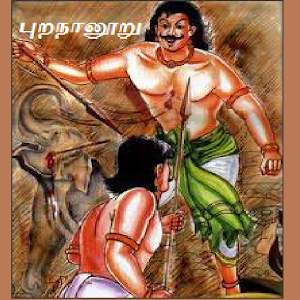
Akam Tinai (அகத்திணை) is a taxonomy of culturally defined time, space, nature and human nature. A tinai (திணை) comprise the absolute poetical landscape (முதற்பொருள்); a precise or explicit time (பொழுது), topographic place (நிலம்), season in which the poem is set; and also includes background elements distinctive of that landscape i.e., flora and fauna, inhabitants, occupation, deities, musical note, musical instrument, and social organization.
Five Landscapes
 |
| Wikimedia Commons |
Five Subjects in Akam Poems

Akam poems have five subjects such as 1. Lovers union is the main theme of Kurinji tinai. It is pre-marital (புணர்தலும் புணர்தல் நிமித்தமும்); 2. Anxious waiting is the theme of Neital tinai. It could be pre-marital or post-marital (இரங்கலும் இரங்கல் நிமித்தமும் (வருந்துதல்); 3. Separation is the theme of Palai. It could be pre-marital or post-marital (பிரிதலும் பிரிதல் நிமித்தமும்); 4. Patient waiting is the theme of Mullai. It could be pre-marital or post-marital (இருத்தலும் இருத்தல் நிமித்தமும்) (காத்து இருத்தல்); 5. Infidelity is the theme of Marutham. It is post-marital (ஊடலும் ஊடல் நிமித்தமும்).
Six Seasons (பெரும்பொழுது) and Six parts of the day
Six parts of the day - four hours each - (சிறுபொழுது) 1. dawn (வைகறை), 2. forenoon (காலை), 3. noon (நண்பகல்), 4. afternoon (ஏற்பாடு), 5. evening (மாலை), and 6. night (யாமம்).
Puram Tinais
Puram poems employ seven tinais or themes based on activity and have been named after flowers: i.e., Vetchi (வெட்சி), Vanji (வஞ்சி), Ulignai (உழிஞை), Thumpai (தும்பை), Vakai (வாகை), Kanji (காஞ்சி) and Padan (பாடாண்). The Tamil kings and chieftains wore different flowers in the battlefield to denote different heroic activities. While invading an enemy's territory the soldiers wore Vanchi (வஞ்சி) flowers and enter into the territory for cattle raids. While raiding the cattle they wore Vetchi (வெட்சி) and wore Ulignai (உழிஞை) flower when the cattle is under siege. They wore Thumpai (தும்பை) flower while engaged in a battle. The victorious soldiers wore Thumpai (தும்பை). Kanji (காஞ்சி) flower indicates tragedy. Padan (பாடாண்) is used to praise the chieftain. The Puram tinai poems are spoken by the poet himself, and frequently associated with real persons, places and events in history.
Hospitality in Sangam Poems
Cuisine is also influenced by regional food laws i.e., moral codes, social codes and religious codes. Sangam Tamil culture valued that feeding everyone, with a smile to those who comes home, as the most important domestic duty of every householder.
Sangam literature is a record of Tamil Nadu history of about 500 – 600 years. According to A.K. Ramanujan, “These poem are ‘classical,’ i.e., early, ancient; they are also ‘classics,’ i.e., works that have stood the test of time, the founding works of a whole tradition. Not to know them is not to know a unique and major poetic achievement of Indian civilization” In Tamil "Virunthu" (விருந்து) means guests. It also means "feast." Tamils are one of the most hospitable people for anybody in the world. Welcoming guests and strangers is part of Tamil culture. It is apt to quote Tolkappiyam and few Sangam poems here: |
| PC: முத்துக்கமலம் |
“விருந்தே தானும்
புதுவது புனைந்த யாப்பின் மேற்றே” (Tolkappiyam.Poem.231)
Sangam Poems
யாதும் ஊரே ; யாவரும் கேளிர் ;
தீதும் நன்றும் பிறர்தர வாரா ;
(Purananuru 192; Poet Kaniyan Poonkundranar)
(Any village, we can live in. Everyone is our kin. Evil and goodness will never come from others.)
Kadalul Mayntha Ilamveruvaluthi, the Pandyan king died in the ocean. There was maritime trade during his reign. The Tamil kings owned ships and traded with many countries. This was the only poem that this king wrote. Nectar of Indiran is known for longevity and even if noble get the nectar of Indiran, they will not drink it alone. They will give up their lives for renown yet will not consent if it comes with dishonor.
உண்டால் அம்ம இவ்வுலகம் இந்திரர்
அமிழ்தம் இயைவதாயினும் இனிது எனத்
தமியர் உண்டலும் இலரே முனிவிலர்
துஞ்சலும் இலர் பிறர் அஞ்சுவது அஞ்சிப்
புகழ் எனின் உயிரும் கொடுக்குவர் பழியெனின்
உலகுடன் பெறினும் கொள்ளலர் அயர்விலர்
அன்ன மாட்சி அனையராகித்
தமக்கென முயலா நோன் தாள்
பிறர்க்கென முயலுநர் உண்மையானே.
(Purananuru 182, Kadalul Mayntha Ilamveruvaluthi)
This world exists because of men who, even if they were to get the nectar of Indiran, will not drink it alone knowing that it is sweet, men with no hatred, without laziness, afraid of what others fear, will give up their lives for fame, but will not accept fame if it comes with dishonor, even if they were to gain the world, men who have no regrets, and with noble virtues, who exert their power, not for themselves but for others!
வல்லார் ஆயினும் வல்லுநர் ஆயினும்
வருந்தி வந்தோர் மருங்கு நோக்கி
அருள வல்லை ஆகுமதி ....
Purananuru 27, Poet Uraiyur Muthukannan Sathanar sang to Cholan Nalankilli
Even if they have talents or not, please shower your graces rapidly on those who come with sorrow,
Poet Mosi Keeranar establishes the place of the king in Tamil Sangam society. He is the lifeline than the rice and water.
நெல்லும் உயிர் அன்றே நீரும் உயிர் அன்றே
மன்னன் உயிர்த்தே மலர்தலை உலகம்
Puranauru 186; Poet Mosi Keeranar,
Rice is not life! Water is not life!
The king is life for this wide world!
அறநெறி முதற்றே அரசின் கொற்றம்
Purananuru 55, Poet Mathurai Maruthan Ilanakanar sang to Pandiyan Ilavanthikaippalli Thunjiya Nanmaran,
Esteemed righteousness is the foremost cause for real victory.
“விருந்தின் மன்னர் அருங்கலம் தெறுப்ப,
வேந்தனும் வெம்பகை தணிந்தனன்”
Akananuru 54, Matroor Kilar Makanar Kotrankotranar,
The new kings have given tributes and our king’s great rage has ebbed.
“விருந்தின் மன்னர் அருங்கலம் தெறுப்ப,
வேந்தனும் வெம்பகை தணிந்தனன்”
Akananuru 54, Matroor Kilar Makanar Kotrankotranar,
The new kings have given tributes and our king’s great rage has ebbed.
“நெல் பல பொலிக! பொன் பெரிது சிறக்க!”
Ainkurunūru 1, Poet Orampokiyar,
May paddy fields yield rich harvest! May the country flourish!
“விளைக வயலே! வருக இரவலர்!”
Ainkurunūru 2, Poet Orampokiyar,
May fields yield harvest! May solicitors come for alms!
“பால்பல ஊறுக! பகடுபல சிறக்க!”
Ainkurunūru 3, Poet Orampokiyar,
May milk flow abundantly! May bulls thrive!
“பசி இல் ஆகுக! பிணிசேண் நீங்குக!”
Ainkurunūru 5, Poet Orampokiyar,
May there be no hunger! May diseases go far away!
“அல்லி லாயினும் விருந்துவரின் உவக்கும்
முல்லை சான்ற கற்பின்
மெல்லியல் குறுமகள்”
Natrinai 142: 9-11, Idaikkadanar,
Even if it is night time, she’ll welcome guests happily, the delicate young lady with virtue suited to wear mullai blossoms.
பகுத்துண்டு பல்லுயிர் ஓம்புதல் நூலோர்
தொகுத்தவற்றுள் எல்லாந் தலை.
(Tirukkural 322; Poet Tiruvalluvar)
Let those that need partake your meal; guard every-thing that lives;
This the chief and sum of lore that hoarded wisdom gives.
According to the poet "the whole design of living in the domestic state and laying up (property) is (to be able) to exercise the benevolence of hospitality." He believes that "the advantages of benevolence cannot be measured; the measure (of the virtue) of the guests (entertained) is the only measure." He is also sure that goddess Lakshmi with joyous mind shall dwell in the house of that man who, with cheerful countenance, entertains the good as guests"
Spurning Meat (புலால் மறுத்தல்)
Non vegetarianism was the main food habit of Sangam Tamils. Rice was consumed as the staple food in Sangam literature. Sangam literature provide abundant information about eating of the meats of Eel (விலங்கு மீன் இறைச்சி ), Murrel fish (Channa striata) (வரால் மீன் இறைச்சி), Mackerel fish (அயிலை மீன் இறைச்சி), Sword fish (வாளை மீன் இறைச்சி), Shark (சுறா இறைச்சி), Tortoise (ஆமைக்கறி), Crab (நண்டுக் கறி), Fowl (காட்டுக்கோழி), Quail (காடை கறி), Partridge (கவுதாரி கறி), rams (செம்மறி ஆடு இறைச்சி), Veal (பசுங்கன்று இறைச்சி), Ox (எருது இறைச்சி), Bison (கடமான் இறைச்சி), porcupine (முள்ளம்பன்றி இறைச்சி), pork (பன்றியிறைச்சி), iguana (உடும்பு இறைச்சி), rabbit (முயல் இறைச்சி), venison (மான் இறைச்சி) etc. They cooked the flesh with ghee and spices. Sangam people inhabited in five varied landscapes and their food habits were shaped by their surrounding environment. Ayars and Idayars enjoyed their dairy products. Uzhavars (farmers) ate roasted flesh rams, fowl, fish, crabs etc., Fishermen consumed fish and drank pottage rice and toddy. Hunters ate venison, iguana and pigs. Brahmin ascetics preferred non vegetarian diets and avoided alcoholic drinks. However Sangam Tamils did not make any differentiation between vegetarian and non-vegetarian food in those days. Sangam literature has employed several words to refer meat varieties: Un (meat), Thu, Thasai (flesh), Thadi (steak), Kurai (large meat / fish slice), Ninam (fat), Pulal (dried meat with smell / dried salt-fish), Vidakkudai, and Muri (bone removed from flesh).
There was no religious restriction and religion never played any role in the food habits of Sangam Tamils. In fact beef eating was prevalent during Sangam period. Their philosophy was that ‘man has every right to eat anything.’ Sangam Tamils were faithful to the concept of the “survival of the fittest” in accordance to the principles of natural selection and evolution.
The civilization of ancient India and ancient Greece are the source for vegetarianism. Vegetarianism is the theory and practice of not eating meat or fish, especially for moral, religious, or health reasons. Vegetarian is a person who does not eat meat or fish, and sometimes other animal products, especially for moral, religious, or health reasons. Vegetarian diet focuses on cereals, pulses, spices, vegetables, and fruits. Many vegetarians give up meat since they have compassion for animals. Nonviolence (ahimsa) towards animals influenced the food habits in ancient India. However Vedic religion in ancient India allowed eating some kinds of meats. Also the religion promoted vegetarianism. According to Manusmriti (a code book for Vedic religion) expresses that, ‘there is no sin in eating meat... but abstention brings great rewards.’
Jain and Buddhist religions exhibited the principle of nonviolence toward animals and prohibited eating meat as early as the 6th century BC. It is learned that Bhadrabahu (433 – 357 century B.C.), the Jain monk proceeded to Shravanabelagula (Karnataka, India) along with Chandra Gupta Maurya (reign: 321–298 B.C.). Later they further travelled towards south to Tamil Nadu to spread Jainism. Preaching of Jainism concentrated around Madurai. Evidences of Jainism in Tamil Nadu can be seen as early as 1st century BC. Sittanavasal Cave near Pudukottai Jainism and Buddism was once followed widely in Tamilnadu. Kancheepuram, Thirunelveli, Ramnathapuram and Madurai were important places where a majority of Jains and Buddist lived.
Emperor Ashoka (268 – 232 B.C) and his son Mahinda were responsible for spreading Buddhism in Tamil Nadu during (400 – 650 A.D). Archaeologists have discovered ancient ruins of a 4th-5th century Buddhist monastery, a Buddha statue, and a Buddhapada (footprint of the Buddha) at Pallavenswaram, near Poompukar. Nagapattinam, a Chola port town finds a place in Buddhist Historical text in Burmese language (3rd Century B.C). The town was also a Buddhist centre till 5th century A.D.
Both Jainism and Buddhism followed the path of ahimsa and brought strong influence on nonviolence towards animals as well as vegetarianism. The habit of meat eating was discouraged and therefore non-vegetarianism was sidelined. Vegetarian food was known as ‘Arugatha food (ஆருகத உணவு).’Arugatham was another name of Jainism. Also there were categorization vegetarianism and non-vegetarianism in the food habits of ancient Tamils. Vegetarianism slowly formed part of religious practice.
The Saivite religion had its origin only around 7th century A.D. Practises animal sacrifice were prevalent in Saivite religion. Over period of time the religious sect evolved as the religion emphasizing vegetarianism. Bakti Movement brought this transformation. Thevaram Trio and Nayanmars onset attacks on Jainism and Buddhism and propagated religious conversion of Jains and Buddhists to Hinduism. At last vegetarianism was accepted as Saivite religious practice.
Poet Saint Tiruvalluvar was a great advocate of Vegetarianism. He abhors the idea of killing animals for consumption of meat. It is the duty of the householders as well as ascetics to practice vegetarianism. He has composed 10 couplets on ‘Spurning of Meat.’
Tirukural 251 well explains that, one cannot be gracious and humane if he feeds his flesh with another being's flesh.
Tirukural 260 advocates vegetarianism on behalf of all living beings. He says that “all that lives will press palms together in prayerful adoration of those who refuse to slaughter and savor meat.”
The distillation of intoxicants was known to ancient India as early as Rig Vedic period. The drink contained substantial amount of ethanol (informally called alcohol). There were two kinds of drinks i.e., Somapana and Surapana which were used by the Indo-Aryan settlers. Ramayana and Mahabharata also mention the habit of drinking. During the reign of Chandra Gupta Maurya, liquor saloons existed under the control of state. Kautilya in his Arthashastra recorded the 'Abkari' policy of the state. Alcohol is a a depressant which in low doses causes euphoria, reduced anxiety, and sociability and in higher doses causes intoxication (drunkenness), stupor and unconsciousness.
Sangam Tamils including kings, warriors, poets, bards and others drank intoxicants (alcohol) to socialize, celebrate and relax. Alcoholic drinks were in abundant supply and were consumed by all classes of people. Consumption of intoxicants (alcohol) played an important social role in Sangam Tamil cultures. Undattu (உண்டாட்டு) is one of the themes of Puram Tinais (புறத்திணைகள்) and it forms part of Vetchi tinai (வெட்சித் தினை). There are five songs in Purananuru.
The alcoholic drinks were known as toddy (கள்) or palm wine. Toddy was brewed from the sap of the palmyra (Borassus flabellifer) and coconut palms (cocos nucifera). இவற்குஈந்து உண்மதி, கள்ளே (Puranauru 290 Poet Avvaiyar). Different kinds of alcoholic drinks such as ariyal (அரியல்), kantharam (கந்தாரம்), madhu (மது), mattu (மட்டு), naravu (நறவு), pizhi (பிழி), theral (தேறல்), topi (டொப்பி) and veri (வேரி) were used during Sangam period. Topi was obtained by fermenting rice and other cereals in “strong mouthed jars” for two days after which they yielded a highly-flavoured wine. Some varieties were obtained from fruits like jack fruit. Wine was also brewed from honey in the mountainous terrains and was matured underground in tightly-lidded jars.
Large Toddy (பெரிய கள்) and Small Toddy (சிறிய கள்) indicated measuring units of alcohol.
The most prominent protagonist of abstinence and powerfully expressed is Tiruvalluvar in his Thirukural (திருக்குறள்) in the chapter 92 on Not Drinking Palm Wine (கள்ளுண்ணாமை).
Tiruvalluvar considers that those who sleeps resembles the dead; (likewise) those who drink are no other than poison-eaters.
Reference
Spurning Meat (புலால் மறுத்தல்)
Non vegetarianism was the main food habit of Sangam Tamils. Rice was consumed as the staple food in Sangam literature. Sangam literature provide abundant information about eating of the meats of Eel (விலங்கு மீன் இறைச்சி ), Murrel fish (Channa striata) (வரால் மீன் இறைச்சி), Mackerel fish (அயிலை மீன் இறைச்சி), Sword fish (வாளை மீன் இறைச்சி), Shark (சுறா இறைச்சி), Tortoise (ஆமைக்கறி), Crab (நண்டுக் கறி), Fowl (காட்டுக்கோழி), Quail (காடை கறி), Partridge (கவுதாரி கறி), rams (செம்மறி ஆடு இறைச்சி), Veal (பசுங்கன்று இறைச்சி), Ox (எருது இறைச்சி), Bison (கடமான் இறைச்சி), porcupine (முள்ளம்பன்றி இறைச்சி), pork (பன்றியிறைச்சி), iguana (உடும்பு இறைச்சி), rabbit (முயல் இறைச்சி), venison (மான் இறைச்சி) etc. They cooked the flesh with ghee and spices. Sangam people inhabited in five varied landscapes and their food habits were shaped by their surrounding environment. Ayars and Idayars enjoyed their dairy products. Uzhavars (farmers) ate roasted flesh rams, fowl, fish, crabs etc., Fishermen consumed fish and drank pottage rice and toddy. Hunters ate venison, iguana and pigs. Brahmin ascetics preferred non vegetarian diets and avoided alcoholic drinks. However Sangam Tamils did not make any differentiation between vegetarian and non-vegetarian food in those days. Sangam literature has employed several words to refer meat varieties: Un (meat), Thu, Thasai (flesh), Thadi (steak), Kurai (large meat / fish slice), Ninam (fat), Pulal (dried meat with smell / dried salt-fish), Vidakkudai, and Muri (bone removed from flesh).
There was no religious restriction and religion never played any role in the food habits of Sangam Tamils. In fact beef eating was prevalent during Sangam period. Their philosophy was that ‘man has every right to eat anything.’ Sangam Tamils were faithful to the concept of the “survival of the fittest” in accordance to the principles of natural selection and evolution.
The civilization of ancient India and ancient Greece are the source for vegetarianism. Vegetarianism is the theory and practice of not eating meat or fish, especially for moral, religious, or health reasons. Vegetarian is a person who does not eat meat or fish, and sometimes other animal products, especially for moral, religious, or health reasons. Vegetarian diet focuses on cereals, pulses, spices, vegetables, and fruits. Many vegetarians give up meat since they have compassion for animals. Nonviolence (ahimsa) towards animals influenced the food habits in ancient India. However Vedic religion in ancient India allowed eating some kinds of meats. Also the religion promoted vegetarianism. According to Manusmriti (a code book for Vedic religion) expresses that, ‘there is no sin in eating meat... but abstention brings great rewards.’
Jain and Buddhist religions exhibited the principle of nonviolence toward animals and prohibited eating meat as early as the 6th century BC. It is learned that Bhadrabahu (433 – 357 century B.C.), the Jain monk proceeded to Shravanabelagula (Karnataka, India) along with Chandra Gupta Maurya (reign: 321–298 B.C.). Later they further travelled towards south to Tamil Nadu to spread Jainism. Preaching of Jainism concentrated around Madurai. Evidences of Jainism in Tamil Nadu can be seen as early as 1st century BC. Sittanavasal Cave near Pudukottai Jainism and Buddism was once followed widely in Tamilnadu. Kancheepuram, Thirunelveli, Ramnathapuram and Madurai were important places where a majority of Jains and Buddist lived.
Emperor Ashoka (268 – 232 B.C) and his son Mahinda were responsible for spreading Buddhism in Tamil Nadu during (400 – 650 A.D). Archaeologists have discovered ancient ruins of a 4th-5th century Buddhist monastery, a Buddha statue, and a Buddhapada (footprint of the Buddha) at Pallavenswaram, near Poompukar. Nagapattinam, a Chola port town finds a place in Buddhist Historical text in Burmese language (3rd Century B.C). The town was also a Buddhist centre till 5th century A.D.
Both Jainism and Buddhism followed the path of ahimsa and brought strong influence on nonviolence towards animals as well as vegetarianism. The habit of meat eating was discouraged and therefore non-vegetarianism was sidelined. Vegetarian food was known as ‘Arugatha food (ஆருகத உணவு).’Arugatham was another name of Jainism. Also there were categorization vegetarianism and non-vegetarianism in the food habits of ancient Tamils. Vegetarianism slowly formed part of religious practice.
The Saivite religion had its origin only around 7th century A.D. Practises animal sacrifice were prevalent in Saivite religion. Over period of time the religious sect evolved as the religion emphasizing vegetarianism. Bakti Movement brought this transformation. Thevaram Trio and Nayanmars onset attacks on Jainism and Buddhism and propagated religious conversion of Jains and Buddhists to Hinduism. At last vegetarianism was accepted as Saivite religious practice.
Poet Saint Tiruvalluvar was a great advocate of Vegetarianism. He abhors the idea of killing animals for consumption of meat. It is the duty of the householders as well as ascetics to practice vegetarianism. He has composed 10 couplets on ‘Spurning of Meat.’
Tirukural 251 well explains that, one cannot be gracious and humane if he feeds his flesh with another being's flesh.
தன்ஊன் பெருக்கற்குத் தான்பிறிது ஊன்உண்பான்
எங்ஙனம் ஆளும் அருள். (Tirukural 251)
What graciousness can one command
Who feeds his flesh by flesh gourmand
கொல்லான் புலாலை மறுத்தானைக் கைகூப்பி
எல்லா உயிரும் தொழும்.
All lives shall lift their palms to him
who eats not flesh nor kills with whim.
AlcoholismThe distillation of intoxicants was known to ancient India as early as Rig Vedic period. The drink contained substantial amount of ethanol (informally called alcohol). There were two kinds of drinks i.e., Somapana and Surapana which were used by the Indo-Aryan settlers. Ramayana and Mahabharata also mention the habit of drinking. During the reign of Chandra Gupta Maurya, liquor saloons existed under the control of state. Kautilya in his Arthashastra recorded the 'Abkari' policy of the state. Alcohol is a a depressant which in low doses causes euphoria, reduced anxiety, and sociability and in higher doses causes intoxication (drunkenness), stupor and unconsciousness.
Sangam Tamils including kings, warriors, poets, bards and others drank intoxicants (alcohol) to socialize, celebrate and relax. Alcoholic drinks were in abundant supply and were consumed by all classes of people. Consumption of intoxicants (alcohol) played an important social role in Sangam Tamil cultures. Undattu (உண்டாட்டு) is one of the themes of Puram Tinais (புறத்திணைகள்) and it forms part of Vetchi tinai (வெட்சித் தினை). There are five songs in Purananuru.
 |
| Palmyra Toddy Tapping |
தேறல் உண்ணும் மன்னே.(Purananuru 298)
The king gives unfiltered toddy
தேள் கடுப்பு அன்ன நாள் படு தேறல்
. (Purananuru 392, Poet Avvaiyar sang for Athiyaman Neduman Anji’s son Poruttu Elini)
Aged toddy as strong as the sting of a scorpion
நிலம் புதைப் பழுனிய மட்டின் தேறல்
புல் வேய்க் குரம்பைக் குடிதொறும் பகர்ந்து
(Purananuru 120, Poet Kapilar)
in every settlement, in the huts roofed with grass, they share the clarified toddy that has been buried and matured in liquor jars,
குறி இறைக் குரம்பைக் குறவர் மாக்கள்
வாங்கு அமைப் பழுனிய தேறல் மகிழ்ந்து
வேங்கை முன்றில் குரவை அயரும்
(Purananuru 129, Poet Uraiyur Enicheri Mudamosiyar sang for Ay Andiran)
Mountain dwellers living in huts with narrow eaves drink aged liquor and perform kuravai dances in the front yards of their houses near vengai trees.
யவனர் நன்கலம் தந்த தண்கமழ் தேறல். (Purananuru 56 Poet Mathurai Kanakkayanar Makanar Nakkeeranar sang to Pandiyan Ilavanthikaippalli Thunjiya Nanmaran)
fragrant and cool wine brought in fine ships by the Greeks
சிறியகட் பெறினே, எமக்கீயும்; மன்னே!
பெரிய கட் பெறினே,
யாம் பாடத், தான்மகிழ்ங்து உண்ணும்.
(Purananuru 235, Poet Avvaiyar sang about Athiyaman Neduman Anji)
If he had a little toddy, he would give it to us. Not any longer. If he had abundant toddy, he would give it to us and happily drink the leftover
Tiruvalluvar advocates not to drink. "Let no liquor be drunk; if it is desired, let it be drunk by those who care not for esteem of the great."
உண்ணற்க கள்ளை உணில்உண்க சான்றோரான்
எண்ணப் படவேண்டா தார். (Tirukural 922)
Drink not inebriating drought. Let him count well the cost. Who drinks, by drinking, all good men's esteem is lost.
Tiruvalluvar pities those who pay and drink and lose consciousness and ranks them as the most ignorant.
கையறி யாமை உடைத்தே பொருள்கொடுத்து
மெய்யறி யாமை கொளல்.(Tirukural 925)
With gift of goods who self-oblivion buys, Is ignorant of all that man should prize.
துஞ்சினார் செத்தாரின் வேறல்லர் எஞ்ஞான்றும்
நஞ்சுண்பார் கள்ளுண் பவர்.(Tirukural 926)
Sleepers are as the dead, no otherwise they seem; Who drink intoxicating droughts, they poison quaff, we deem.
- Absolute Astronomy Sangam http://www.absoluteastronomy.com/topics/Sangam
- Beef Eating in the Ancient Tamizhagam. K. V. Ramakrishna Rao (A paper presented during the 57th session of Indian History Congress held at Madras from December 27-29, 1996). July 7, 2013
- Cuisine Wikipedia
- Drinking habits in ancient Indiahttps://www.ncbi.nlm.nih.gov/pmc/articles/PMC4776591/
- Early Prohibition Phase in Tamil Country. http://aygrt.isrj.org/UploadedData/8105.pdf
- Gajabahu synchronism Wikipedia
- History of vegetarianism Wikipedia
- Indian food http://quatr.us/india/food/
- Myth of Tamil Sangams https://controversialhistory.blogspot.in/search?updated-max=2007-07-11T03:00:00-07:00&max-results=5&start=80&by-date=false
- Sangam Literature Wikipedia
- Sangam Literature – சான்றோர் செய்யுள் https://sangamtamilliterature.wordpress.com/sangam-tamil-books/
- Sangam Period in South Indian History: Part I Tamilakam, Sangam Period and Sangam Literature. Muthusamy R. Know Your Heritage. http://know-your-heritage.blogspot.in/2013/12/sangam-period-in-south-indian-history_8.html
- Sources of ancient Tamil History Wikipedia http://en.wikipedia.org/wiki/Sources_of_ancient_Tamil_history
- Tamil Cuisine Wikipedia
- Thirukkural Abstinence from Meat. http://tamilvegan.blogspot.in/p/tamil-veganism-blogen-gbtranslations.html
- What is sangam age? https://www.quora.com/What-is-sangam-age
- What is Toddy Drink? http://www.mostinside.com/advantages-disadvantages-of-toddy-drink/
- உணவும் மதுவும் ப. சரவணன். http://www.tamilpaper.net/?p=8964
- தமிழர் பண்பாட்டில் விருந்தோம்பல். மா. பத்மபிரியா. முத்துக்கமலம்
- திணை விளக்கம் Wikipedia
YouTube

